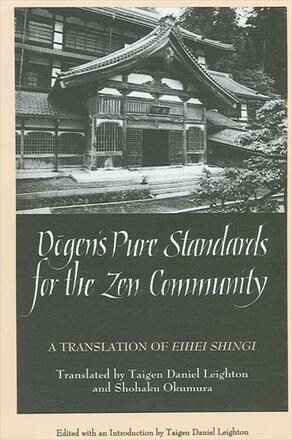Today's Talk will be with Master Dogen's BENDOHO, The Model For Engaging The Way. Please see below in this thread.
Please 'sit-a-long' with our MONTHLY 4-hour ZAZENKAI, netcast LIVE 8am to noon Japan time Saturday morning (that is New York 7pm to 11pm, Los Angeles 4pm to 8pm (Friday night), London midnight to 4am and Paris 1am to 4am (early Saturday morning)) ... and visible at the following link during those times ...
... to be visible on the below screen during those times and any time thereafter ...
LIVE ZAZENKAI NETCAST at GOOGLE+ IS HERE:
CLICK ON THE TAB ON LOWER RIGHT FOR 'FULL SCREEN
FOR THOSE NOT ALREADY MEMBERS OF THE CIRCLE WHO WISH TO JOIN TO SIT LIVE WITH A CAMERA, INSTRUCTIONS are posted AT THIS LINK. WE ARE NOW LIMITED TO 10 INDIVIDUALS WITH CAMERAS, BUT ANY NUMBER CAN WATCH LIVE 'ONE WAY' AND SIT-A-LONG VIA THE ABOVE SCREEN. IF JOINING WITH CAMERA, PLEASE MAKE SURE YOUR MICROPHONE IS MUTED:
The Sitting Schedule is as follows;
00:00 - 00:50 CEREMONY (HEART SUTRA / SANDOKAI IN ENGLISH) & ZAZEN
00:50 - 01:00 KINHIN
01:00 - 01:30 ZAZEN
01:30 - 01:50 KINHIN
01:50 - 02:30 DHARMA TALK & ZAZEN
02:30 - 02:40 KINHIN
02:40 - 03:15 ZAZEN
03:15 - 03:30 KINHIN
03:30 - 04:00 METTA CHANT & ZAZEN, VERSE OF ATONEMENT, FOUR VOWS, & CLOSING
Our Zazenkai consists of our chanting the 'Heart Sutra' and the 'Identity of Relative and Absolute (Sandokai)' in English (please download our Chant Book at the link below), some full floor prostrations (please follow along with me ... or a simple Gassho can be substituted if you wish), a little talk by me ... and we close with the 'Metta Chant', followed at the end with the 'Verse of Atonement' and 'The Four Vows'. Oh, and lots and lots of Zazen and walkin' Kinhin in between!
Please download and print out the Chants we will recite at the following link (PDF):
Chant Book (PDF)
or
Chant Book (SHORT VERSION HTML)
I STRONGLY SUGGEST THAT YOU POSITION YOUR ZAFU ON THE FLOOR IN A PLACE WHERE YOU ARE NOT STARING DIRECTLY AT THE COMPUTER SCREEN, BUT CAN GLANCE OVER AND SEE THE SCREEN WHEN NECESSARY. YOUR ZAFU SHOULD ALSO BE IN A POSITION WHERE YOU CAN SEE THE COMPUTER SCREEN WHILE STANDING IN FRONT OF THE ZAFU FOR THE CEREMONIES, AND HAVE ROOM FOR BOWING AND KINHIN.
ALSO, REMEMBER TO SET YOUR COMPUTER (& SCREEN SAVER) SO THAT IT DOES NOT SHUT OFF DURING THE 4 HOURS.
I hope you will join us ... an open Zafu is waiting. When we drop all thought of 'here' 'there' 'now' 'then' ... we are sitting all together!
Gassho, Jundo
Please 'sit-a-long' with our MONTHLY 4-hour ZAZENKAI, netcast LIVE 8am to noon Japan time Saturday morning (that is New York 7pm to 11pm, Los Angeles 4pm to 8pm (Friday night), London midnight to 4am and Paris 1am to 4am (early Saturday morning)) ... and visible at the following link during those times ...
... to be visible on the below screen during those times and any time thereafter ...
LIVE ZAZENKAI NETCAST at GOOGLE+ IS HERE:
CLICK ON THE TAB ON LOWER RIGHT FOR 'FULL SCREEN
FOR THOSE NOT ALREADY MEMBERS OF THE CIRCLE WHO WISH TO JOIN TO SIT LIVE WITH A CAMERA, INSTRUCTIONS are posted AT THIS LINK. WE ARE NOW LIMITED TO 10 INDIVIDUALS WITH CAMERAS, BUT ANY NUMBER CAN WATCH LIVE 'ONE WAY' AND SIT-A-LONG VIA THE ABOVE SCREEN. IF JOINING WITH CAMERA, PLEASE MAKE SURE YOUR MICROPHONE IS MUTED:
The Sitting Schedule is as follows;
00:00 - 00:50 CEREMONY (HEART SUTRA / SANDOKAI IN ENGLISH) & ZAZEN
00:50 - 01:00 KINHIN
01:00 - 01:30 ZAZEN
01:30 - 01:50 KINHIN
01:50 - 02:30 DHARMA TALK & ZAZEN
02:30 - 02:40 KINHIN
02:40 - 03:15 ZAZEN
03:15 - 03:30 KINHIN
03:30 - 04:00 METTA CHANT & ZAZEN, VERSE OF ATONEMENT, FOUR VOWS, & CLOSING
Our Zazenkai consists of our chanting the 'Heart Sutra' and the 'Identity of Relative and Absolute (Sandokai)' in English (please download our Chant Book at the link below), some full floor prostrations (please follow along with me ... or a simple Gassho can be substituted if you wish), a little talk by me ... and we close with the 'Metta Chant', followed at the end with the 'Verse of Atonement' and 'The Four Vows'. Oh, and lots and lots of Zazen and walkin' Kinhin in between!
Please download and print out the Chants we will recite at the following link (PDF):
Chant Book (PDF)
or
Chant Book (SHORT VERSION HTML)
I STRONGLY SUGGEST THAT YOU POSITION YOUR ZAFU ON THE FLOOR IN A PLACE WHERE YOU ARE NOT STARING DIRECTLY AT THE COMPUTER SCREEN, BUT CAN GLANCE OVER AND SEE THE SCREEN WHEN NECESSARY. YOUR ZAFU SHOULD ALSO BE IN A POSITION WHERE YOU CAN SEE THE COMPUTER SCREEN WHILE STANDING IN FRONT OF THE ZAFU FOR THE CEREMONIES, AND HAVE ROOM FOR BOWING AND KINHIN.
ALSO, REMEMBER TO SET YOUR COMPUTER (& SCREEN SAVER) SO THAT IT DOES NOT SHUT OFF DURING THE 4 HOURS.
I hope you will join us ... an open Zafu is waiting. When we drop all thought of 'here' 'there' 'now' 'then' ... we are sitting all together!
Gassho, Jundo

 )
) 


Comment